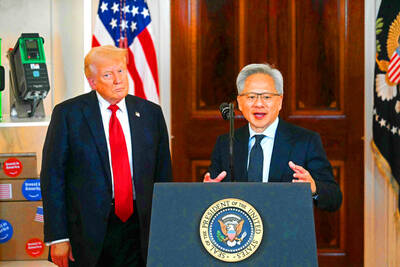The US dollar on Friday posted a second week of gains after a turbulent few days when currencies were buffeted by shifting risk appetite, with the market’s focus on next week’s US Federal Reserve meeting.
However, some analysts wondered whether the US dollar’s recent rally might be losing momentum.
The US dollar index, which measures the greenback against a basket of six major currencies, rose slightly for the day to 92.91. For the week, added 0.2 percent, after rising 0.6 percent previously.
However, that was off a three-and-a-half-month high of 93.194 hit on Wednesday, after strong Wall Street earnings helped investors regain some confidence amid earlier worries that the Delta variant of SARS-CoV-2 could derail the global recovery.
In Taipei, the New Taiwan dollar fell against the greenback, losing NT$0.010 to close at NT$28.028, little changed from last week’s NT$28.005.
Risk appetite among investors remained high on Friday, with US stocks rising, US Treasuries selling off, most commodity currencies well-bid on the day and the greenback off its peaks.
“The dollar looks tired especially after the rally of the last few weeks,” said Erik Nelson, macro strategist at Wells Fargo Securities in New York. “It seems to be running out of steam both from a fundamental and technical perspective.”
So far this month, the US dollar has gained 0.6 percent, after rising 2.8 percent last month.
However, Nelson was not convinced that the dollar could hold its gains in the coming weeks given the decline in US Treasury yields.
Since the beginning of this month, US benchmark 10-year Treasury yields have lost 16 basis points, on track for their largest monthly fall since March last year.
Against the safe-harbor yen, the US dollar rose 0.3 percent to ¥110.53.
The Australian dollar — viewed as a proxy for risk appetite — slid 0.1 percent to US$0.7374, posting a fourth straight weekly loss. With half the Australian population under lockdown, economists said the country’s central bank could increase stimulus rather than decrease it at its next policy meeting.
Additional reporting by CNA, with staff writer

Taiwan Semiconductor Manufacturing Co (TSMC, 台積電) last week recorded an increase in the number of shareholders to the highest in almost eight months, despite its share price falling 3.38 percent from the previous week, Taiwan Stock Exchange data released on Saturday showed. As of Friday, TSMC had 1.88 million shareholders, the most since the week of April 25 and an increase of 31,870 from the previous week, the data showed. The number of shareholders jumped despite a drop of NT$50 (US$1.59), or 3.38 percent, in TSMC’s share price from a week earlier to NT$1,430, as investors took profits from their earlier gains

AI TALENT: No financial details were released about the deal, in which top Groq executives, including its CEO, would join Nvidia to help advance the technology Nvidia Corp has agreed to a licensing deal with artificial intelligence (AI) start-up Groq, furthering its investments in companies connected to the AI boom and gaining the right to add a new type of technology to its products. The world’s largest publicly traded company has paid for the right to use Groq’s technology and is to integrate its chip design into future products. Some of the start-up’s executives are leaving to join Nvidia to help with that effort, the companies said. Groq would continue as an independent company with a new chief executive, it said on Wednesday in a post on its Web

CHINA RIVAL: The chips are positioned to compete with Nvidia’s Hopper and Blackwell products and would enable clusters connecting more than 100,000 chips Moore Threads Technology Co (摩爾線程) introduced a new generation of chips aimed at reducing artificial intelligence (AI) developers’ dependence on Nvidia Corp’s hardware, just weeks after pulling off one of the most successful Chinese initial public offerings (IPOs) in years. “These products will significantly enhance world-class computing speed and capabilities that all developers aspire to,” Moore Threads CEO Zhang Jianzhong (張建中), a former Nvidia executive, said on Saturday at a company event in Beijing. “We hope they can meet the needs of more developers in China so that you no longer need to wait for advanced foreign products.” Chinese chipmakers are in

POLICY REVERSAL: The decision to allow sales of Nvidia’s H200 chips to China came after years of tightening controls and has drawn objections among some Republicans US House Republicans are calling for arms-sale-style congressional oversight of artificial intelligence (AI) chip exports as US President Donald Trump’s administration moves to approve licenses for Nvidia Corp to ship its H200 processor to China. US Representative Brian Mast, the Republican chairman of the US House Committee on Foreign Affairs, which oversees export controls, on Friday introduced a bill dubbed the AI Overwatch Act that would require the US Congress to be notified of AI chips sales to adversaries. Any processors equal to or higher in capabilities than Nvidia’s H20 would be subject to oversight, the draft bill says. Lawmakers would have